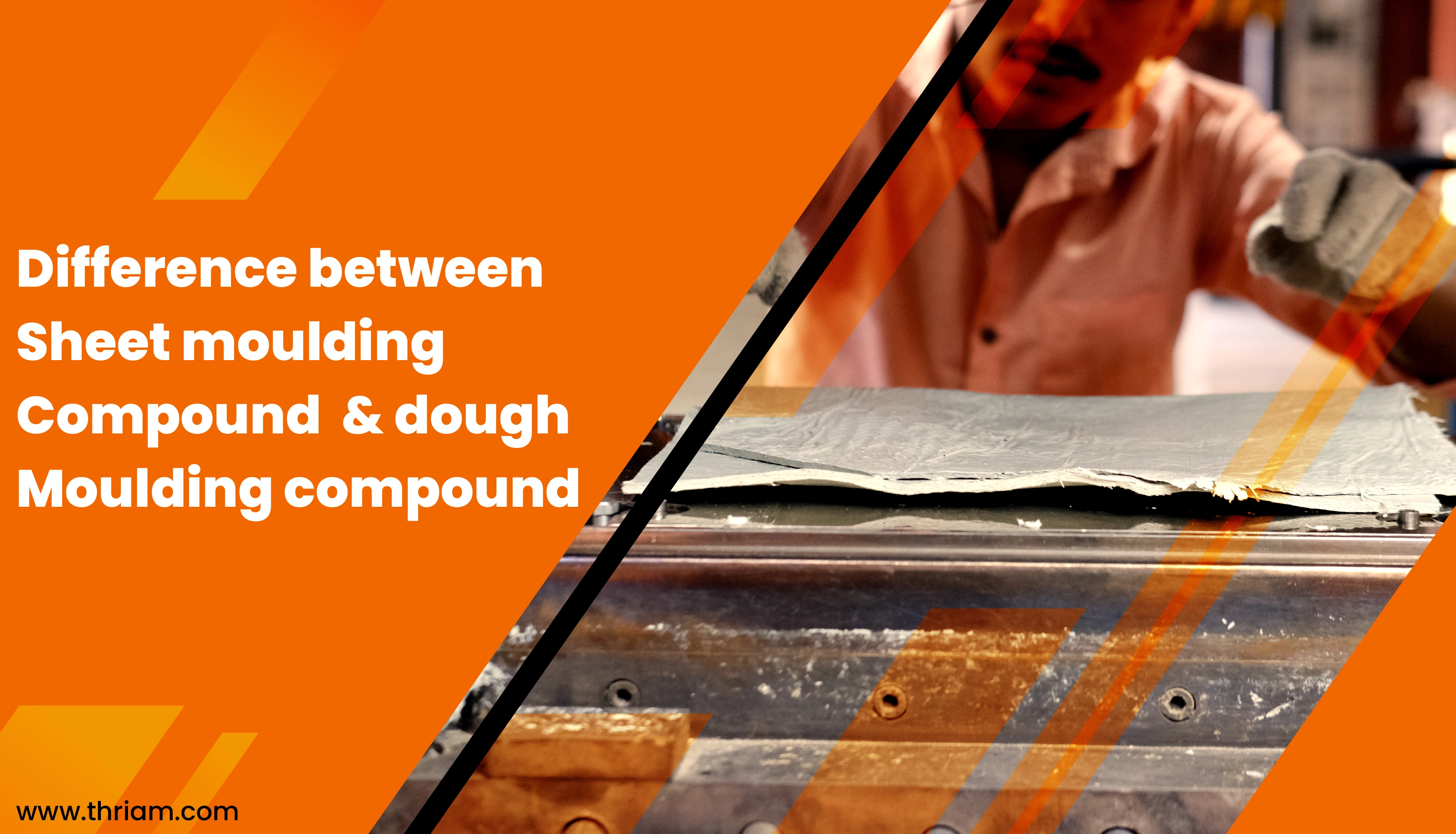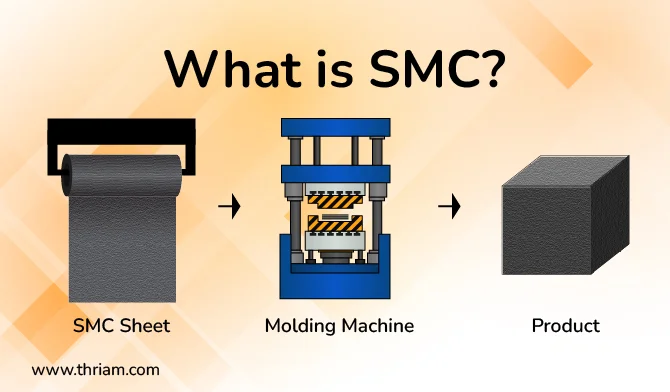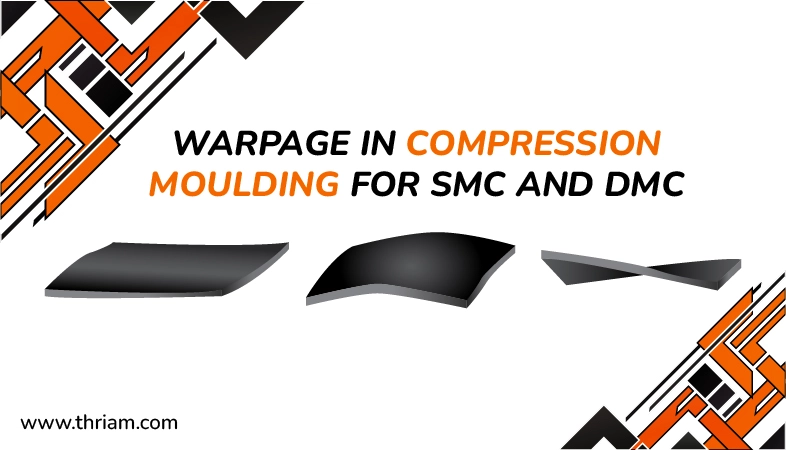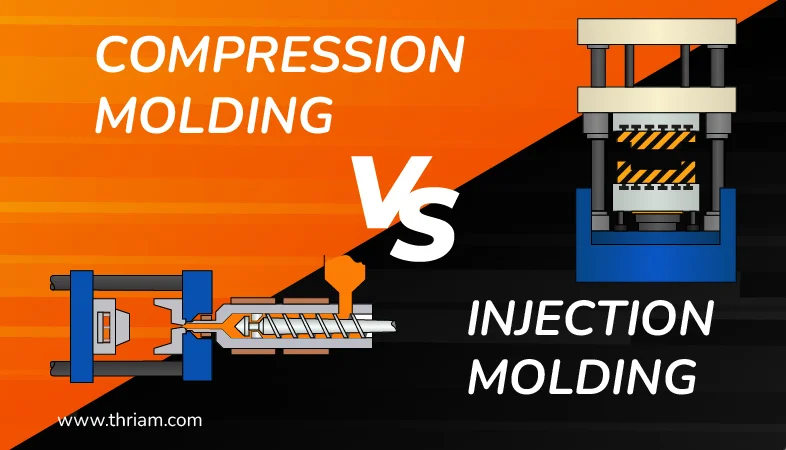Unveiling the Difference: Sheet Moulding Compound (SMC) vs Dough Moulding Compound (DMC)

Thermoset composite materials are a type of composite material that exhibit enhanced properties like high strength, stiffness, and durability. They are widely used in various industries, including automotive, aerospace, and construction, due to their unique characteristics.Sheet Moulding Compound (SMC) and Dough Moulding Compound (DMC) are two types of thermoset composites.
Understanding the differences between SMC and DMC is important when selecting the right material for specific applications. For example, if a manufacturer needs to produce components that require high-strength, SMC is a suitable option. However, if electrical insulation is important, DMC would be the ideal choice.
Definition and Composition of SMC:
Sheet Moulding Compound (SMC) is a composite material consisting of a thermosetting resin matrix, reinforcing fibers (typically glass fibers), and various additives. The resin matrix is usually a blend of unsaturated polyester, vinyl ester, or epoxy resins. These resins provide excellent mechanical strength, chemical resistance, and heat resistance properties. The reinforcing fibers enhance the strength and stiffness of the composite.
Sheet Moulding Compound (SMC) and its primary components
Sheet Moulding Compound (SMC) is a type of composite material that is widely used in various industries, including automotive, aerospace, and construction. SMC is known for its exceptional strength-to-weight ratio, corrosion resistance, and dimensional stability. It is composed of several primary components that work together to create a high-performance material.
The primary components of Sheet Moulding Compound (SMC) include a thermosetting resin matrix, reinforcing fibers, and various additives. The thermosetting resin matrix is a cross-linked polymer that provides the material with its structural integrity and mechanical properties. Commonly used thermosetting resins in SMC include polyester, vinyl ester, and epoxy.
Reinforcing fibers play a crucial role in enhancing the strength and stiffness of SMC. These fibers, which are typically glass, carbon, or aramid fibers, are embedded within the resin matrix, forming a composite structure. The reinforcement fibers provide SMC with its high tensile and flexural strength, allowing it to withstand external forces and loads.
Additives are another essential component of SMC. They can include fillers, pigments, stabilizers, and release agents. Fillers, such as calcium carbonate or talc, help to improve the dimensional stability, reduce shrinkage, and enhance the flowability of the material during the molding process. Pigments are added to give the SMC its desired color or appearance. Stabilizers may be included to enhance the chemical resistance or UV resistance of the material. Release agents facilitate the easy removal of the SMC from the molds during the manufacturing process.
The manufacturing process of SMC involves several steps. First, the reinforcing fibers are impregnated with the resin matrix. Then, the mixture of resin and fibers is thoroughly mixed to ensure proper distribution and alignment of the fibers. Next, the mixture is formed into sheets or rolls to create the SMC material. Lastly, the SMC is subjected to heat and pressure using compression molding techniques to cure and shape it into the desired form.
The primary components of SMC work in harmony to create a material with excellent mechanical properties. The resin matrix contributes to the overall integrity of the composite, while the reinforcing fibers enhance its strength and stiffness. Additives provide additional functionality and improve the manufacturing process.
SMC finds applications in a wide range of industries due to its desirable properties. It is commonly used in the automotive industry for manufacturing lightweight body panels, bumpers, and structural components. In the aerospace sector, SMC is utilized for interior panels, aircraft fairings, and other lightweight structural parts. Additionally, SMC is employed in the construction industry for applications like facade panels and infrastructure components.
Manufacturing process for SMC
-vs-dough-moulding-compound-(dmc)-blog-banner-by-Thriam.webp)
The manufacturing process for SMC involves several steps, including mixing, forming, and curing. Below is a description of the typical manufacturing process for SMC.
Step 1: Mixing
The first step in manufacturing SMC involves thoroughly mixing the primary components. The thermosetting resin matrix is combined with reinforcing fibers and various additives. The mixture is homogenized to ensure that the fibers are evenly distributed throughout the resin matrix. Depending on the application, additional fillers, pigments, stabilizers and release agents may also be added.
Step 2: Forming
Once the mixture is thoroughly mixed, it is formed into sheets or rolls. This process is typically accomplished using a machine that spreads the mixture out onto a moving conveyor. The surface of the mixture is smoothed out to produce even thickness sheets or rolls.
Step 3: Curing
After the SMC is formed into sheets or rolls, it is placed under heat and pressure to cure the material. This curing process involves a controlled temperature and pressure environment, which partially or fully cures the resin matrix causing it to harden and solidify.
Definition and Composition of DMC:
Dough Moulding Compound (DMC) is a type of composite material that is widely used in the manufacturing industry. DMC is known for its excellent molding properties, dimensional stability, and high strength. It is composed of several primary components that work together to create a versatile and durable material.
The primary components of Dough Moulding Compound (DMC) include a thermosetting resin, fillers, reinforcing fibers, and various additives. The thermosetting resin, typically polyester or vinyl ester, acts as the matrix that holds the other components together. This resin provides DMC with its structural integrity and rigidity.
Explaining Dough Moulding Compound (DMC) and its primary components
Dough Moulding Compound (DMC) is a type of composite material that is used widely in various industries. It is a versatile material that provides excellent molding characteristics, dimensional stability, and high strength. DMC is composed of several primary components that work together to create a stable, reliable, and durable material.
The primary components of DMC include a thermosetting resin, fillers, reinforcing fibers, and various additives. The thermosetting resin, typically polyester or vinyl ester, acts as a matrix that holds the other components together and provides structural integrity to the material. This resin is critical in the cross-linking process that provides DMC with its high strength, stiffness, and dimensional stability.
Fillers are added to the DMC formulation to enhance its mechanical properties and reduce overall material costs. Common fillers for DMC include calcium carbonate, mineral fibers, and other powdered materials. These fillers improve DMC's dimensional stability, strength, and impact resistance.
Reinforcing fibers, such as glass or carbon fibers, are included in DMC to improve its strength, stiffness and toughness. These fibers vary in length but are typically short and randomly distributed throughout the matrix. By forming a reinforced network, the fibers enhance the DMC's mechanical properties, making it capable of withstanding external forces and loads.
Various additives may also be incorporated into the DMC formulation to improve its processing characteristics and performance. These additives may include lubricants, release agents, pigments, flame retardants, or UV stabilizers. For instance, lubricants allow for easier moldability and release from the molds, while release agents prevent the DMC from sticking to the molds. Pigments are added to provide color to the finished product, while flame retardants and UV stabilizers enhance the DMC's fire resistance and durability.
The manufacturing process for DMC usually involves blending the dry ingredients such as the resin, fillers, and additives to form a homogenous mixture. The mixture is then compounded to achieve the desired consistency, and the compounded material is then transferred into a heated mold cavity for shaping and curing. Through the heating and pressure, the thermosetting resin cross-links, resulting in a strong, rigid, stable, and durable final product.
DMC is widely used across several industries for making high-quality electrical and electronic components, automotive parts, household appliances, construction materials, and many other applications. With excellent molding properties, high strength, dimensional stability, and versatility, DMC continues to be a valuable material in various manufacturing industries.
Manufacturing process for DMC
Dough Moulding Compound (DMC) is a versatile composite material widely used in various industries for its excellent molding characteristics, dimensional stability, and high strength. The manufacturing process for DMC involves several steps that result in a stable, reliable, and durable final product.
The first step in the manufacturing process for DMC is the preparation of the raw materials. DMC is composed of a thermosetting resin, fillers, reinforcing fibers, and various additives. The thermosetting resin, typically polyester or vinyl ester, acts as a matrix that holds the other components together and provides structural integrity to the material. Fillers, such as calcium carbonate or mineral fibers, are added to improve dimensional stability, strength, and impact resistance. Reinforcing fibers, such as glass or carbon fibers, are included to enhance strength, stiffness, and toughness. Additives may also be incorporated to improve processing characteristics, such as lubricants, release agents, pigments, flame retardants, or UV stabilizers.
Once the raw materials are prepared, they are blended together to form a homogenous mixture. This blending process ensures that the resin, fillers, fibers, and additives are uniformly distributed throughout the compound. The mixture is usually compounded using mixing equipment to achieve the desired consistency and uniformity.
The manufacturing process for DMC combines the preparation of raw materials, blending, molding, and curing. Each step is critical in producing high-quality DMC parts with excellent mechanical properties, dimensional stability, and durability.
Strengths and Limitations:
Unique strengths and advantages of SMC over DMC
Sheet Moulding Compound (SMC) and Dough Moulding Compound (DMC) are both popular composite materials with unique strengths and advantages. While they share similarities in terms of their production process and general properties, there are distinct characteristics that set them apart. Understanding these differences can help identify the unique strengths of SMC over DMC.
One of the primary advantages of SMC over DMC is its superior surface finish. SMC parts have a smoother and more refined surface, making them highly suitable for applications where aesthetics are important. The smooth surface of SMC allows for better paint adhesion, resulting in a higher-quality, more visually appealing final product.
Another area where SMC excels is in its processing efficiency. SMC is a highly moldable material that can be easily shaped into complex forms using various molding techniques. It has shorter molding cycles and faster production times compared to DMC. This efficiency is advantageous for high-volume manufacturing applications where productivity and cost-effectiveness are critical factors.
In terms of mechanical properties, SMC offers higher impact resistance and toughness compared to DMC. SMC is composed of a higher percentage of reinforcing fibers, resulting in stronger and more durable parts. This increased impact resistance makes SMC an ideal choice for applications that require superior strength and reliability, such as automotive components and structural parts. On the other hand, DMC's lower fiber content makes it more suitable for applications that do not require as high of a mechanical strength.
Additionally, SMC exhibits better dimensional stability compared to DMC. SMC has a lower coefficient of thermal expansion, meaning it experiences minimal dimensional changes with temperature fluctuations. This characteristic ensures that SMC parts maintain their shape and precision dimensions over a wide range of operating conditions. As a result, SMC is often preferred for applications that require excellent dimensional accuracy and stability, such as in telecommunications or electrical equipment.
Furthermore, SMC has excellent dielectric properties, making it a preferred choice for electrical insulation applications. It possesses high electrical resistivity, low dielectric constant, and low dissipation factor, ensuring optimal electrical performance and reliability. This advantage allows SMC to be widely used in industries such as power distribution, electrical enclosures, and transformers.
Unique strengths and advantages of DMC over SMC
One of the primary advantages of DMC over SMC is its flexibility and versatility in terms of part design. DMC has a relatively lower viscosity compared to SMC, allowing it to flow more easily during the molding process. This characteristic enables the production of complex shapes and intricate details that may be challenging to achieve with SMC. Therefore, DMC is often preferred for applications that require intricate designs or customization options.
Another notable strength of DMC is its enhanced resistance to heat and fire. DMC possesses higher thermal resistance and flame-retardant properties when compared to SMC. This advantage makes DMC a suitable choice for applications where exposure to high temperatures or fire risk is a concern, such as in electrical systems, automotive components, or industrial machinery.
DMC also exhibits better moisture resistance and dimensional stability compared to SMC. Due to its composition, DMC has a lower water absorption rate, preventing moisture-related issues such as warping or degradation. Additionally, DMC has a lower coefficient of thermal expansion, meaning it undergoes less dimensional change with temperature variations. This characteristic ensures that DMC parts maintain their shape and structural integrity even under fluctuating environmental conditions.
Furthermore, DMC offers excellent electrical insulation properties. It has high dielectric strength and low electrical conductivity, making it a reliable choice for electrical and electronic applications. DMC parts can effectively isolate and protect electrical components, minimizing the risk of electrical short circuits or malfunctions.
Additionally, DMC is often more cost-effective than SMC. The production process for DMC involves fewer steps and less equipment compared to SMC, resulting in decreased manufacturing costs.This affordability makes DMC a preferred option for applications where cost is a significant consideration.
Limitations and drawbacks of SMC
One of the primary concerns with SMC is its brittleness at low temperatures. SMC tends to become more brittle and susceptible to cracking at low temperatures. This issue limits the use of SMC in applications that require good toughness, impact resistance, and ductility in cold conditions. To avoid this limitation, it is recommended to use SMC in applications where cold temperatures are not a significant concern.
Another limitation of SMC is its relatively high density. SMC parts tend to be heavier than comparable parts made from other composite materials. This increased density may cause weight-related issues, such as decreased fuel efficiency or reduced load capacity in transportation systems. To address this drawback, it may be necessary to consider alternative lightweight composite materials for some applications.
SMC also exhibits moderate moisture absorption. While SMC has good resistance to water and moisture, it can absorb small amounts of water over time. This limitation can result in part deformation, warping, or corrosion in some cases, especially when exposed to harsh environmental conditions. To overcome this drawback, it is essential to take appropriate measures, such as using protective coatings or optimizing the manufacturing process to ensure water resistance.
Another potential limitation of SMC is its limited post-molding adaptability. Once an SMC part is molded, it cannot be reformed or shaped further without risking damage or degrading its properties. This limitation may restrict the design flexibility or customization options in some manufacturing applications. However, this concern can be addressed by carefully planning the part design and optimizing the molding process to achieve the desired final product.
Limitations and drawbacks of DMC
One limitation of DMC is its reduced strength compared to other composite materials. DMC has a lower fiber content, resulting in lower mechanical properties and reduced tensile strength and stiffness. This drawback may restrict its use in applications that require high structural integrity or load-bearing capabilities. It is important to evaluate the specific strength requirements of a project before deciding to use DMC.
DMC is also more sensitive to moisture absorption compared to other composite materials. While DMC generally has good resistance to moisture, it can absorb small amounts of water over time. This limitation may cause swelling, warping, or degradation of the material if exposed to prolonged moisture. Care should be taken to protect DMC parts from excessive moisture or proper steps should be taken in design and production to mitigate this issue.
Another potential limitation of DMC is its limited heat resistance. DMC has lower thermal stability compared to other composite materials, which may restrict its use in applications that involve high-temperature environments or thermal cycling. Excessive heat exposure can cause the material to soften, lose its shape, or even degrade. For applications with high-temperature requirements, it may be necessary to consider alternative materials.
DMC parts may also be susceptible to dimensional variations during the molding and curing process. The shrinkage and expansion that occur during DMC's curing phase can lead to part distortion or improper fitment. Detailed mold design and precise process control are crucial to minimize these dimensional variations and achieve accurate part dimensions.
Additionally, DMC may have limited color and design options compared to some other materials. The color choices and finishes available for DMC may be more limited, which could be a constraint for applications that require specific colors or intricate designs.
Conclusion
In conclusion, both Sheet Moulding Compound (SMC) and Dough Moulding Compound (DMC) are popular composite materials utilized in various industries for their unique characteristics and benefits. SMC and DMC have different strengths and weaknesses, which make them more suitable for certain applications than others.
SMC has excellent mechanical strength and toughness, making it suitable for applications that require impact resistance and load-bearing capabilities. It is also a lightweight material, which makes it ideal for transportation applications. However, SMC is prone to brittleness at low temperatures and may have limited design flexibility.
DMC is a more versatile material with better dimensional stability, electrical insulation properties, and resistance to heat and fire. Its lower viscosity allows for intricate design and customization options and makes it easier to mold and shape. Nevertheless, DMC has relatively lower mechanical strength and may not be the best material for load-bearing applications.
Manufacturers should carefully consider the specific needs and requirements of their projects and evaluate the strengths and limitations of each material before selecting the most appropriate option. SMC and DMC offer distinct benefits that make each ideal for specific applications, and understanding these differences is crucial in ensuring successful and efficient manufacturing processes.



